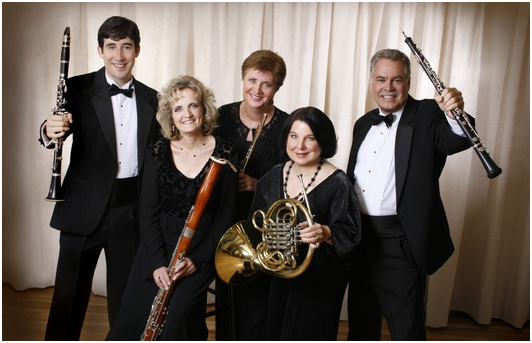Quintet of the Americas: “Wind Chamber Music from 1983-2014 by Roberto Sierra”
Two fine new pieces by Roberto Sierra are the highlights of a thoughtfully-chosen and well-played program.

Quintet of the Americas: Nick Gallas, Maureen Strenge, Karla Moe, Barbara Oldham and Matt Sullivan
[avatar user=”Eric Grunin” size=”96″ align=”left” ] Eric Grunin, Critic[/avatar]The Quintet of the Americas, founded in 1976, has a long relationship with composer Roberto Sierra. Their May 7 concert was built around two of his newest pieces, complemented by two of his works from the early 1980’s. Sierra, born and raised in Puerto Rico, is best known for his relatively conservative orchestral works, which often incorporate elements of popular Latin musical styles. They’re spirited, optimistic, public music, and quite enjoyable as such; however, his chamber works stay fresh longer, perhaps because their greater complexity means that you hear new things with each listening.
This is not to say that the popular influence is only for show. The concert program illumined this unexpectedly with a work by the Hungarian master György Ligeti. Sierra studied with Ligeti in the late 70’s, at which time Ligeti was well into his mature (and wonderful) ‘micropolyphonies’. But at this concert, the Quintet presented Ligeti’s Six Bagatelles of 1956, a work early enough to show the influence of his compatriot Bartok, and with that a clear bright line was drawn from Bartok’s use of Hungarian folk music, to Ligeti’s hyper-refinement of Bartok’s rhythmic and harmonic methods, to Sierra’s incorporation of tropes from Latin popular music.
The concert began with the New York premiere of Estudios para quinteto de vientos. Completed in 2012, these twelve etudes are less technical drills for the musicians than demonstrations of the composer’s craft, and in this they are worthy kin to such classics as Carter’s Eight Etudes and a Fantasy and Ligeti’s Ten Pieces of 1968. Each movement establishes a specific sound-world and process, works it through, and leaves before we tire of it. Every so often an idea from one piece will recur in another, more than enough to keep the collection from seeming a mere chocolate box (not that there would be anything wrong with that). The salseado of #3 recurred in #9, the slow and expressive heterophony of #4 became a cantus firmus in #5, and then running unisons in #12. Also notable were #7, a faint habanera recalled in sadness, and #10, whose ruminative blurring seemed to allude to Ligeti’s signature cloud-clusters.
Next was Ligeti’s aforementioned Six Bagatelles, fun and technically accomplished but nothing like his mature work. The most notable movements are the last two: #5 Bela Bartok in memoriam. Adagio. Mesto, naturally brought to mind the older composer’s Sixth Quartet. #6, Molto vivace. Capriccioso, has a mocking, clowning character that anticipates Nino Rota’s work for Fellini. The program notes that this last movement was “censored” and withheld from the work’s 1956 premiere because it was deemed “too dangerous”; Ligeti emigrated to the West that December.
Following intermission, the program resumed with Sierra’s Salsa para vientos of 1982, which has been a staple of the Quintet’s repertory almost since it appeared. Each movement combines characteristic Afro-Caribbean rhythms and a modernist harmonic palette, with pleasing and very accessible results. Sierra describes the ending as a “cadenza with tropical insects,” which is just what it sounds like.
Next came Doña Rosita, for mezzo-soprano and winds, and if this six-minute concert aria was less effective than the rest of the program the fault is partly in the choice of text. A monologue from Garcia Lorca’s play Doña Rosita the Spinster, as presented here, it’s meditative and digressive, with no dramatic urgency, and although Sierra nicely mirrors its changing moods, he hasn’t found a way to keep the line taut. (It’s possible that the whole approach is wrong: that moment in the play is a young woman talking suggestively to two others about love and sex, so perhaps an uptempo approach would have been better.) Mezzo Anna Tonna managed the vocal part with grace, but was given few opportunities to shine.
Last was the gem of the concert, Sierra’s new Sexteto para piano y vientos in its first performance anywhere. This piece is a concertino in three movements, and often the winds become an extension of the piano, sustaining and elaborating its lines and motifs. If I mention that its textures and gestures were occasionally reminiscent of the Ligeti Piano Concerto, or the Stravinsky Capriccio, I mean that as high praise. I don’t know why the combination of piano and wind quintet isn’t more popular, but I recommend this very strongly to any quintet that’s looking for an alternative to the somewhat overexposed Poulenc Sextuor. Pianist Jeanne Golan did an excellent job with her challenging part.
The Quintet of the Americas are Karla Moe (flute), Matt Sullivan (oboe), Nick Gallas (clarinet), Barbara Oldham (horn), Gina Cuffari (bassoon).
Quintet of the Americas: “Wind Chamber Music from 1983-2014 by Roberto Sierra” (May 7, 2014)
Americas Society
680 Park Avenue, at 68th Street, in Manhattan
For more information, visit http://www.quintet.org/concerts


Leave a comment